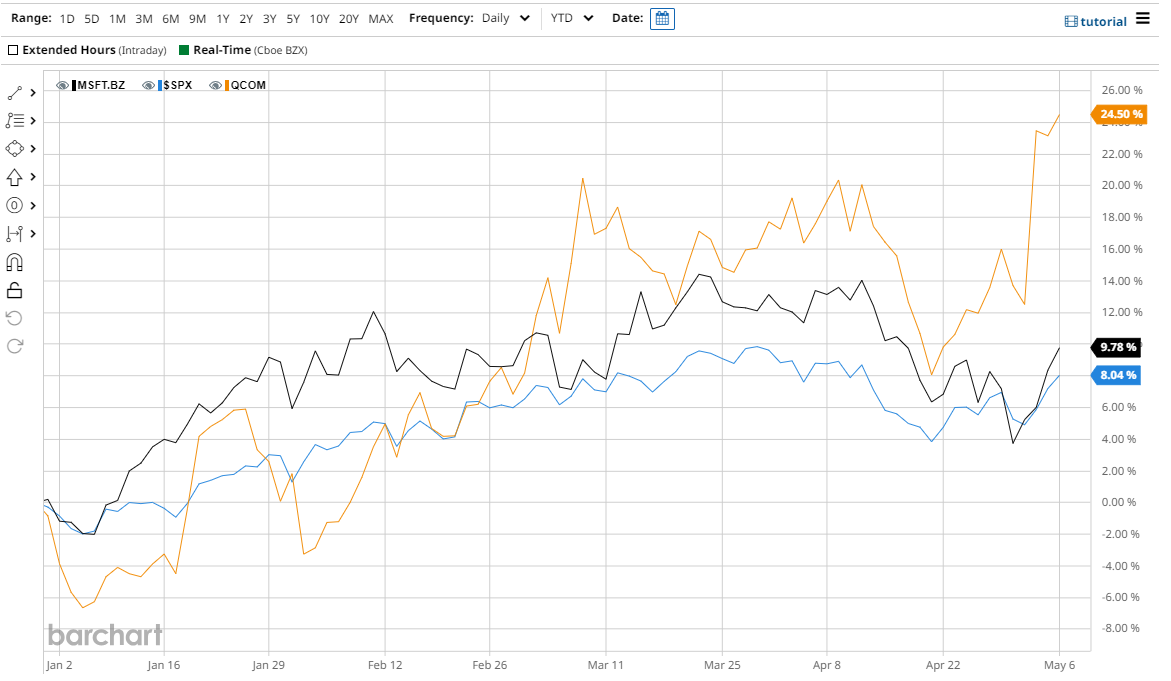While some politicians have more luck in the stock markets than others, their big-money trades continue to grab headlines – whether it’s Senator Ted Cruz’s recent action to dump Goldman Sachs (GS), or the recent flurry of trading in artificial intelligence (AI) heavyweight Nvidia (NVDA) by various Congress members, headlined by former Speaker Nancy Pelosi.
Another recent addition to this list is Rep. Marjorie Taylor Greene (R-GA), the outspoken House representative for Georgia’s 14th congressional district since 2021. Greene has been an active participant in the markets lately, but a couple of purchases in particular stood out in late April – she picked up shares of two tech giants just before they reported blockbuster earnings.
A Bold Move: Investing in Microsoft and Qualcomm Ahead of Earnings
In a recent Congressional trading form filing dated May 1, Greene disclosed purchases of Microsoft (MSFT) and Qualcomm (QCOM) worth up to $15,000 each. The purchases were made on April 24, just ahead of the latest earnings releases from both companies – MSFT on April 25, and QCOM on May 1.
In Q3 of FY24, Microsoft’s revenue increased by 17% from the previous year to $61.9 billion, powered by its cloud business. EPS rose even more sharply, up 20% to $2.94, surpassing the consensus estimate of $2.82. Further, the company ended the quarter with a cash and equivalents balance of about $80 billion.
As for Qualcomm, quarterly revenue rose by 1% from the year-ago period to $9.4 billion. EPS climbed 13.5% from the prior year to $2.44, topping the consensus estimate of $2.33. Further, Qualcomm exited the March quarter with a cash balance of $9.2 billion. QCOM notched a one-day gain of 9.7% on the results.
After well-received quarterly reports, MSFT and QCOM are both outperforming the broader S&P 500 Index ($SPX) on a YTD basis. MSFT is up 9.6% for the year, while QCOM has rallied 25%.
Notably, Greene’s other stock purchases on April 24 included Tractor Supply Co (TSCO), Home Depot (HD), Hershey (HSY), Berkshire Hathaway (BRK.B), and some of that Goldman Sachs stock that Cruz didn’t want. So far, QCOM is her best investment, up more than 9% since her purchase.
For what it’s worth, Greene sits on the Homeland Security and Oversight and Accountability Committees.
AI Influence: Driving Growth for MSFT and QCOM
Both Microsoft and Qualcomm are poised to capitalize on the booming AI market, but their strategies differ.
Microsoft leverages its cloud prowess and invests heavily in partnerships and internal AI development. It recently unveiled its Phi-3-min Small Language Model, designed for on-device processing without needing an internet connection. This expands AI accessibility to areas with limited infrastructure.
Additionally, the Azure cloud platform offers PaaS, SaaS, and IaaS solutions, locking in customers with its strong product portfolio and high switching costs. Moreover, in February, it partnered with French startup Mistral AI. The deal would give Mistral AI access to Azure infrastructure, and Microsoft would provide its customers access to Mistral AI’s models.
Qualcomm, meanwhile, focuses on the automotive industry, boasting a $45 billion design pipeline in this sector. As autonomous driving takes center stage, Qualcomm’s chip development specifically caters to this automotive revolution.
On the AI front, Qualcomm prioritizes sustainability, claiming its chips offer superior energy efficiency compared to competitors, a potential game-changer. This, coupled with the overall AI market growth, positions Qualcomm for substantial business expansion in the AI field. Further, their QCT AI business boasts the Snapdragon X Plus platform, the world’s fastest NPU for laptops, processing 45 TOPS.
In essence, Microsoft and Qualcomm are well-positioned in the AI megatrend, each with distinct strengths: Microsoft through its cloud-centric approach and partnerships, and Qualcomm through its focus on the automotive industry and energy-efficient chip development.
Dividends and Analyst Expectations
Both MSFT and QCOM are dividend-paying tech companies.
Qualcomm offers a dividend yield of 1.78%, which is above the sector median of 1.025%. The company has been raising its dividends for the past 20 years, and maintains a modest payout ratio of 35.2%.
Microsoft’s dividend yield of 0.7% isn’t the most generous, but it has been raising dividends for the past 19 years. Also, its payout ratio of 25.4% leaves plenty of room for those critical AI investments, while leaving room for continued dividend growth.
Market Analysts’ Prognostications
Analysts seem to share MTG’s optimism when it comes to MSFT and QCOM.
Analysts have a consensus rating of “Strong Buy” for Microsoft, with a mean target price of $470.26. This denotes an upside potential of about 13.6% from current levels. Out of 37 analysts covering the stock, 33 have a “Strong Buy” rating, 3 have a “Moderate Buy” rating, and 1 has a “Hold” rating.
When it comes to Qualcomm, analysts have an average rating of “Moderate Buy,” with a mean target price of $180.71, which would imply the stock is just about fairly valued at current levels. However, the Street-high target price of $485 suggests an impressive upside potential of roughly 166% from current levels.

